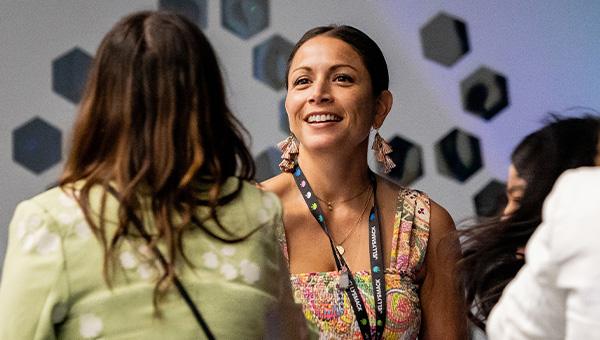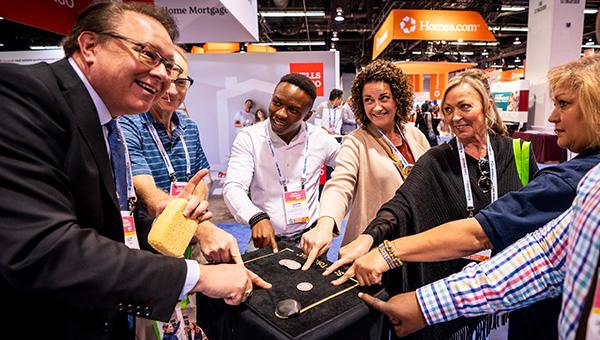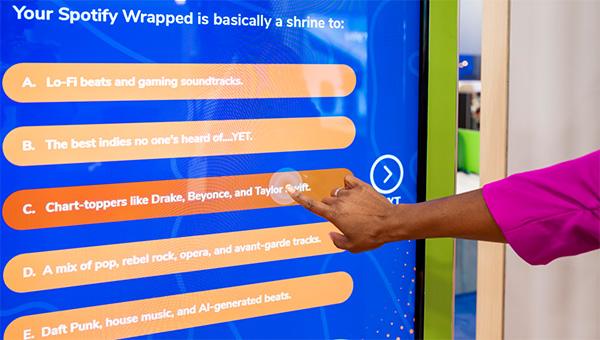Designing by listening
Innovative, scalable, and, yes, beautiful.
At Freeman, we are fueled by innovation and our commitment to designing sustainability into everything. Today we sit down with a team of product experts to discuss how they are providing customers with a new, innovative product line.

Mike Wohlitz
SVP Design Operations & Enablement

Sandra Davis
VP, Product Management

Stephanie Rush
Director, Modular Build Systems

Masaru Haruyama
Executive Creative Director

Jason Oliver
Regional Director of Modular Build Systems

I’d like to start at a high level. Innovation is one of Freeman’s core values. Things change around here a lot. For example, we shifted towards more sustainable practices. This new line of cabinets, counters, and waterfall tables are a great example of this. Sandra, what led to the development of this?

As you said, we evolved to this. Partly because it’s who we are. But also, our clients’ needs evolved. They have higher expectations, more choices, access to more research, and so on. They also want to leave the world a better place. And so do their attendees. This is true of all our clients.

How did we begin to understand what some of their needs were?

We simply listen to our clients. There was also a lot of research. Cross-functional research. Venue research. Specific show research. Focus groups.

That our clients are interested in building relationships at every level that provides value, innovation, and sustainability. They’re also very discerning when it comes to style, functionality, and the interactions in their space. It’s about what you’re trying to achieve, and how those products support those goals.

That’s interesting. Let me then ask Mas something. Tell me about the design methodology of how we meet our clients’ different needs and visions.

We always start with listening to the customer and our internal people. Stakeholders, sales, operations delivery, and so on. We took those insights and made a palette that would work with all kinds of corporate brands and event brands. It’s neutral and simple, but really sophisticated. We then looked at scale and proportion. You have these series of dimensions that are consistent. This creates a design language of beautiful proportions that appeal to 99% of the population. You’re able to take these designs and multiply it across different assets, scales, and design types to create a unified look and feel.

I mean, one of the recent product innovations have furnishings that could sit in my home. It’s got that level of quality. Stephanie, what partnerships did we build to bring this to reality for our clients?

We partnered with a manufacturer with expertise in durable retail fixtures. This means working with new products and materials. For example, we’re using a durable marine board product for the countertops.

Why is that such a differentiator?

It’s a more sustainable option because it lasts longer. It’s the same type of material used on boats, so it’s a quality material that can withstand the wear and tear of the trade show industry.

So, the days of my coffee stains seeping into the melamine countertop are gone?

Yep. No more rings. It’s Mike-proof. We use powder-coated metal now. There’s quality hardware, and integrated cable management. We have all these different finishes. The quality and aesthetic are elevated across the entire line. All the pieces can really be used together in a bunch of different arrangements. It’s not your grandma’s trade show product.

So, Jason, tell me how you design something that might sit in a home and is robust enough to handle the harshest trade show environments.

It’s designed with more modern materials with longer lifespans. The metal toe-kick – it’s virtually indestructible. The marine board top is a game changer, right? Scratch free. Dent free. And it can be turned around very quickly.

What is everyone on the show floor saying about it?

Our clients have been thrilled with their upgraded aesthetic and functionality. We can provide them with a range of options we couldn’t previously. Like, adjustable shelves, the electrical access, six-way power distribution built in. And everybody loves the look of them, especially with the offerings we didn’t currently have.

To add to that, I believe this offering is really a reflection of the varied tastes of our clients. We have a differentiator now of a deliberate strategy to integrate best-in-class suppliers from complementary industries. That translates into better products that meet higher quality expectations.

Exactly, meeting those expectations is what we’re all about. So Mas, with that in mind, talk to me about how we delivered on what’s important to our clients and team. Like, the trapdoor for electrical connectivity, the inclusion of a power strip.

We simply asked what they care about and what their concerns are. Hours and hours of input from the stakeholders are all integrated into a very simple, sophisticated design. So, things like trap doors to make it easier to pull electrical things like the subtle notch that you have at the metal base to accommodate handles.

Yep, every part has a purpose. This is a key principle that helps guide Freeman innovation. It’s not enough to innovate. It needs to be more. It needs to be positive, efficient, and sustainable.
Ready to set a higher bar with your design?



